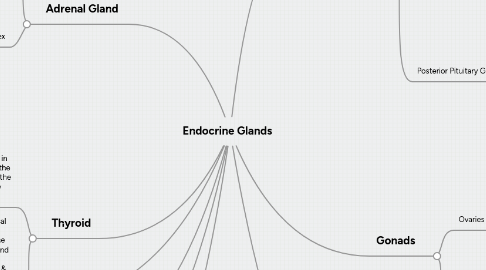
1. Pineal Gland
1.1. Melatonin - regulates sleep and seasonal reproductive cycles, "biological clock", biorhythms
2. Thymus
2.1. Thymosin - stimulates maturation of cells of immune system
3. Pancreas
3.1. Insulin - decreases blood glucose levels
3.2. Glucagon - increases blood glucose levels
4. Parathyroid
4.1. Parathormone - stimulates release of calcium from bones
5. Adrenal Gland
5.1. Adrenal Medulla
5.1.1. "fight or flight"
5.1.1.1. 2 Catecholamines: Epinephrine and Norepinephrine (adrenaline and noradrenaline) - increase levels of sugar and fatty acids in blood
5.2. Adrenal Cortex
5.2.1. Glucocorticoids (cortisol)- regulate sugar, fat, protein metabolism; stress response
5.2.2. Mineralocorticoids (aldosterone) - increase re-absorption of salt and water in kidney and excrete potassium; fluid and electrolyte imbalance
5.2.3. Sex Hormones- Testosterone and estrogen - causes masculinization of body features
6. Thyroid
6.1. Calcitonin - Lowers calcium in the blood by moving it into the bones, increases calcium in the urine, works antagonistically with PTH
6.2. Thyroxine (T3): Increases basal metabolic rate and oxygen consumption, especially in the heart, skeletal muscle, liver, and kidney Triiodothyronin (T4): Growth & development, metabolism, body temperature and heart rate.
7. Others
7.1. Organ Specific Hormones
7.1.1. Kidney
7.1.1.1. Renin - acts on blood proteins to produce angiotensin, which regulates blood pressure
7.1.2. Digestive tract
7.1.2.1. Secretin, Gastrin, Cholecystokinin, etc. - control secretion of mucus, enzymes, salts, and digestion
7.1.3. Liver
7.1.3.1. Insulin like growth factor (IGF-1) mediates action of growth hormone
7.2. Prostaglandins - regulate smooth muscle contraction and inflammatory response
7.3. Adipose Tissue Hormone - a very nasty gland (cytokines) development of heart disease, DM, and joint disease
8. Pituitary Gland
8.1. Anterior Pituitary Gland (adenohypophysis)
8.1.1. Prolactin (PRL) - stimulates milk synthesis and secretion from mammary glands
8.1.2. Adrenocorticoptropic Hormone (ACTH) - stimulates adrenal cortex to release its steroids (cortisol, aldosterone, and sex hormones)
8.1.3. Gonadotropic Hormones
8.1.3.1. Follicle-stimulating hormone (FSH) - stimulates development of the ova and sperm
8.1.3.2. Luteinizing hormone (LH) - stimulates ovulation and progesterone/testosterone
8.1.4. Thyroid Stimulating Hormone (TSH) - stimulates thyroid to release T3 and T4
8.1.5. Growth Hormone (GH) or somatotropin- stimulates growth of bone and muscle, protein synthesis, fat metabolism, and synthesis glucose during fasting
8.2. Posterior Pituitary Gland (neurohypophsis)
8.2.1. Antidiuretic Hormone (ADH) - Prevents urine formation, reabsorbs water, triggered by pain, low blood pressure and drugs, high amounts cause vasoconstriction
8.2.2. Oxytocin - uterus contractions during childbirth, mammary glands release of milk AKA "milk letting"
9. Gonads
9.1. Ovaries
9.1.1. Estrogen - causes development of female secondary sexual characteristics and maturation of eggs like development of breasts, growth of hair in genital area and under arms, widening of hips, and an increase in body fat
9.1.2. Progesterone - stimulates development of uterine lining, formation of placenta, maintains pregnancy, inhibits ovulation and contribute to abnormal menstrual periods and menopausal symptoms
9.2. Testes
9.2.1. Testosterone - stimulates development of male secondary sexual characteristics and stimulates speratogenesis

